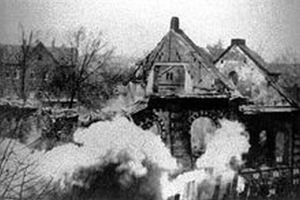It includes scores for more than 100 historic synagogues.
 Brussels, August 10 – The European Union has published a new guidebook for tourists and tour guides interested in visiting houses of worship, updated to reflect the sensibilities of today’s discerning traveler. As such, it includes a rating system that gives synagogues on the Continent a score based on how well they would burn if set alight.
Brussels, August 10 – The European Union has published a new guidebook for tourists and tour guides interested in visiting houses of worship, updated to reflect the sensibilities of today’s discerning traveler. As such, it includes a rating system that gives synagogues on the Continent a score based on how well they would burn if set alight.
The 356-page publication devotes most of its attention to historic cathedrals and other sites of religious pilgrimage, but, in a nod to the evolving sensibilities of the twenty-first century tourist, also features a new take on Jewish community buildings and spiritual centers both active and defunct, and a score of 1-10 to indicate how flammable they are. It includes scores for more than 100 historic synagogues, some of which have been transformed into museums of Jewish culture and history, and some into public facilities unrelated to their history.
In its introduction, a group of Ministers of Tourism for EU member states explain the utility of the new guide, which is available both online in PDF form and at the concierge desks of all major European hotel chains. The introduction gives a list of the guidebook’s advantages over other, previous publications, and spends several paragraphs specifically touting the benefits of the synagogue flammability index, which the ministers call “an unprecedented tool.”
“We hope this rating system gives our guests the information they need and want in deciding what destinations offer the most fulfilling experience,” they write. “The immersion in essential aspects of European heritage and culture has become ever-easier, and our visitors from within the EU and from abroad can be better informed as they participate in that culture.”
Beyond the basic information conveyed by the flammability rating for each synagogue, the guide provides other pertinent information regarding each one, such as whether the facility functions as something other than a synagogue, such that its destruction by arson would adversely affect people beyond the Jewish community. For example, numerous historic synagogues in Eastern Europe that made it through Nazi and Communist rule structurally intact were transformed into libraries, offices, hotels, or other non-synagogue purposes in the years following the Second World War. Burning down such structures would cause significant damage to the local non-Jewish community, and burning down such a synagogue would thus be rendered “not recommended.” The guide exhorts its users to thoroughly review the other pertinent information before making use of any particular synagogue flammability rating.
In the next edition, the editors expect to have fewer synagogues to cover. Instead, they intend to include a chapter on Nazi extermination camps and the relative ease with which each one could be brought back online.




